The NVIDIA Titan V Deep Learning Deep Dive: It's All About The Tensor Cores
by Nate Oh on July 3, 2018 10:15 AM ESTRevisiting Volta: How to Accelerate Deep Learning
While we’ve gone over Volta’s distinguishing characteristics several times now, the marquee addition of tensor cores somewhat overshadows all the other changes that supplement or outright support tensor core usage. For one, as we've already seen, it's tightly tied into the improved SIMT model with Volta's independent thread scheduling and collective groups.
Mixed Precision: Making FP16 Work for Deep Learning
Ultimately, Volta’s deep learning prowess is built on utilizing half precision (IEEE-754 FP16) rather than single precision (FP32) for deep learning training. First supported by cuDNN 3 and implemented in Tegra X1’s Maxwell cores, native half precision compute was fully introduced with Pascal as “Pseudo FP16”, where FP32 ALUs could instead process pairs of FP16 instructions for theoretically double FP16 throughput per clock. We've actually seen this in how tensor cores deal with matrix fragments in the register, as the two FP16 input matrices are gathered in 8 elements of FP16x2, or 16 FP16 elements.
In terms of FP32 versus FP16, because the single precision format ‘describes’ more data than half precision, operations are more computationally intensive and more memory storage/bandwidth is needed to house and transfer the data, in turn consuming more power. So the successful usage of lower precision in compute has been a poor man’s holy grail of sorts, targeting applications where higher precision is unnecessary.
Aside from API/compiler/framework support, the perennial drawback for deep learning is the (unsurprising) loss of precision in using FP16 data types, where the training process would not be accurate enough and so the model cannot converge. Enter mixed precision.
To be fair, NVIDIA has wheeled out the 'mixed precision' term before in very similar context, in discussing Pascal's fast FP16 (for GP100) and DP4A/DP2A integer dot product operations (for GP102, GP104, and GP106 GPUs). Back then, the focus was on inference, and very much like Titan V's 'deep learning TFLOPS,' Titan X (Pascal) launched with a "44 TOPS (new deep learning inferencing instruction)." The new instructions performed integer dot products on 4-element 8-bit vectors or 2-element 8-bit/16-bit vectors, resulting in a 32-bit integer product that could be accumulated with other 32-bit integers.
So for mixed precision in Volta, there are several more wrinkles. First is that important precision-sensitive data like master weights are stored as FP32. The second is tensor cores, where mixed precision training describes how two half precision input matrices are multiplied to get a single precision product, which is then accumulated into a single precision sum. NVIDIA has stated that the result is converted back to half precision before being written into memory, though how this happens is not exactly clear. For inferencing purposes though, the tensor core will instead accumulate the result into a half precision sum. Ultimately, when using half precision format, less data is needed in the registers and memory, which helps compensate for the data in very large matrices.
For a given training iteration, Volta mixed precision means the master weights are copied in single and half precision, and while that takes up more memory, NVIDIA believes the accuracy gains are worth it. The half precision weights are used in the ensuing computations, and when the master weights are ready to be updated with the resulting computation, the FP32 copy is used. At that last stage of an iteration, the computed weight updates are converted from FP16 to FP32 in order to update the FP32 master copy of weights, again for accuracy reasons.
Recalling that FP16 does not cover the same data space as FP32, a normalization method can resolve issues where an FP32 value is outside the representable range of FP16 and thus would be converted to a zero. For example, values of many activation gradients would fall outside of the range of FP16, but because these values are clustered together, multiplying the loss with a scaling factor moves most of the values in the range of FP16. The gradients are re-scaled to the original range before weight updates are done, maintaining the original precision.
Not all math, neural networks, and layers work well with FP16 storage or math, so depending on the framework or type of neural net, FP16 will either be disabled by default or not recommended. In general, mixed precision with FP16 and tensor cores are best suited with convolution and RNN-heavy image processing and the like. For the most part, cuDNN handles a lot, and developers may only need a few pointers from NVIDIA's Mixed Precision guide. Meanwhile, cuBLAS and CUTLASS also include tensor core support. Altogether, especially with with the maturation of cuDNN it is hard to imagine tensor cores being succesful without it. Intrepid developers can continue trying to wrangle tensor cores directly in CUDA C++, PTX, and the like, though as we have seen tensor cores are, as far as generally programmable GPU blocks go, rather inflexible.
Volta and Pascal: Memory Improvements, SM Changes, and More
With mixed precision tensor cores, it would seem like the memory bandwidth issue was mitigated. As it turns out, not very much, despite the fact that Volta has received memory subsystem enhancements nearly across the board.
For one, Volta now has a 12 KiB L0 instruction cache, and while Pascal and others have had instruction buffers before, Volta's more efficient L0 is private to the sub-core SM partitions. And by that, it is private to the warp scheduler. This compensates for the larger instruction size of Volta's new ISA, and more likely than not, contributes to the framework supporting tensor core thoroughput, which uses the presumably beefy HMMA on a warp-based level. Instruction latency is also reduced from Pascal, notably with core FMAs down to 4 cycles from 6, which we previously confirmed.
With the ratio of schedulers per SM increased, the loss of the second dispatch port seems to be a tradeoff in favor of independent sub-core with separate data paths and math dispatch unit; with simultaneous FP32/INT32 execution capability, it also opens the door to other lower precision/mixed precision models. Overall, the sub-core enhancements that we detailed earlier look to optimize the tensor core array.
Another big change was merging the L1 cache and shared memory. While in the same block, the shared memory is configurable up to 96 KiB per SM. The HBM2 controller was also updated, and NVIDIA and others have noted 10 - 15% increase in efficiency.
Summing up the SM, Volta looks to be building around a new style of independent partition that supports tensor cores, and one leaning far more on the compute side than on gaming.


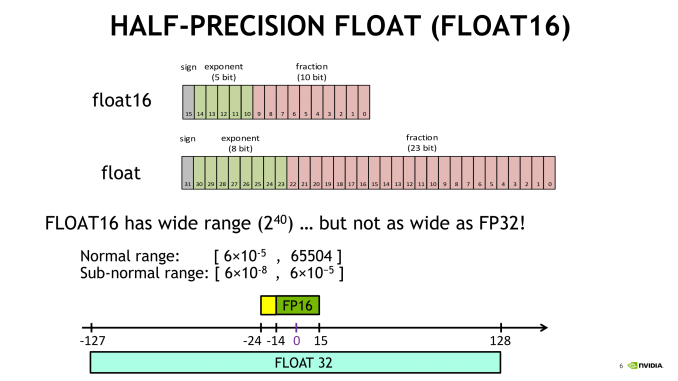
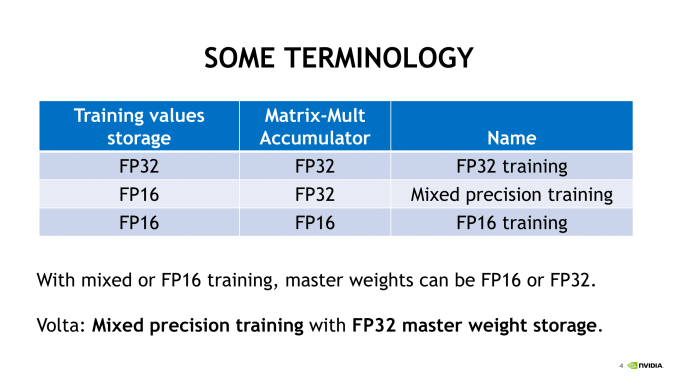
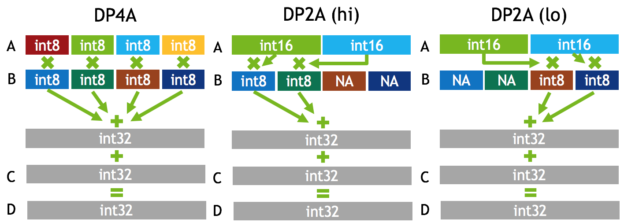
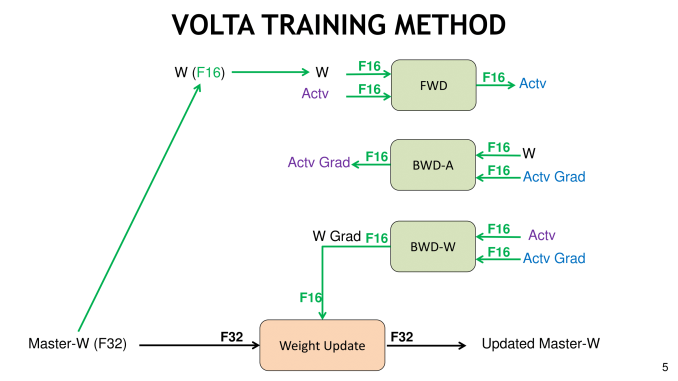
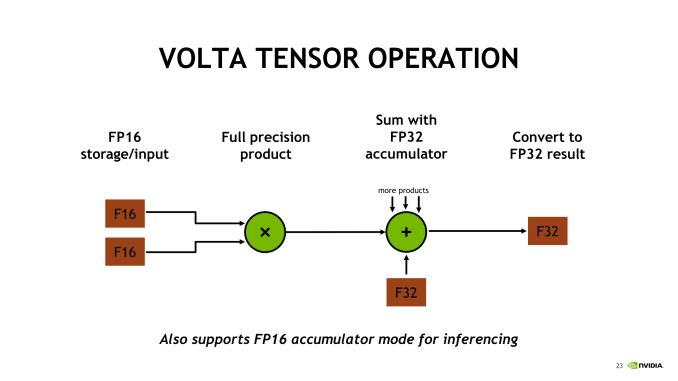
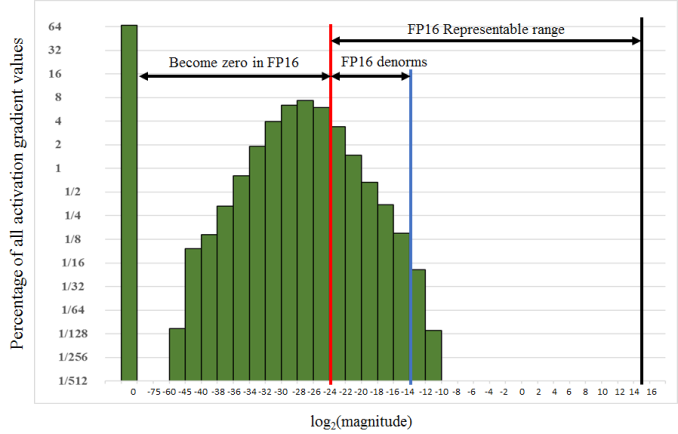
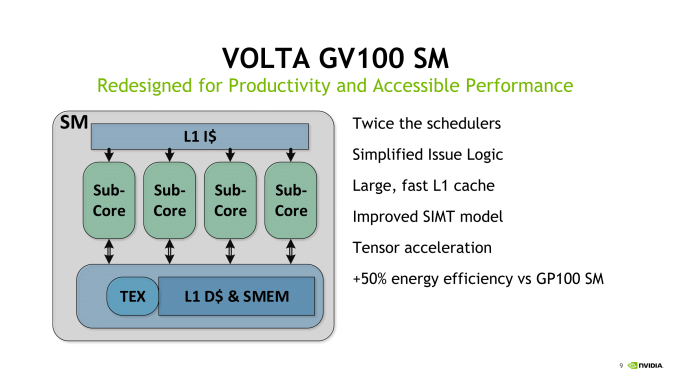
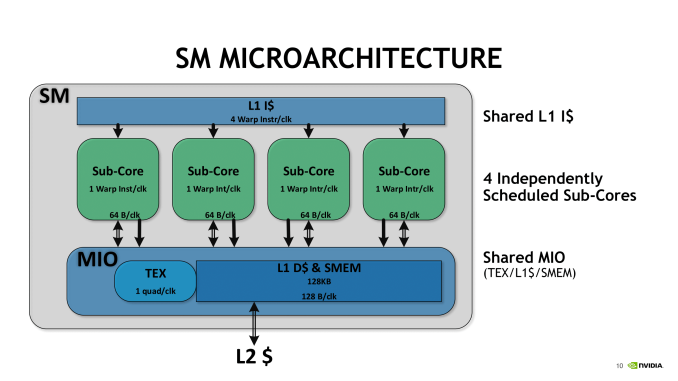
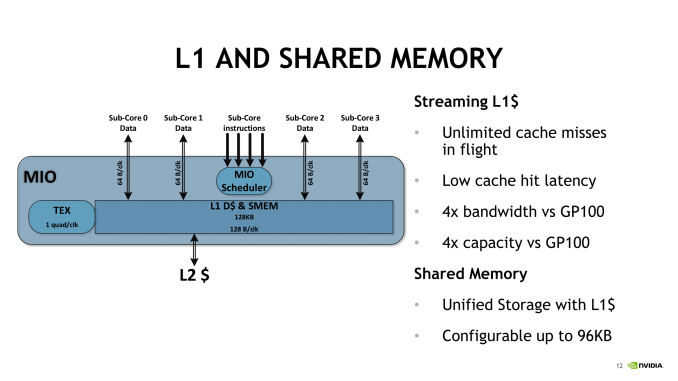








65 Comments
View All Comments
Nate Oh - Wednesday, July 11, 2018 - link
Thanks for your inquisitive responses throughout :)And yes, I was trying to be impartial with AMD's claims about deep learning. Until I have results myself, I offer them a degree of the benefit of the doubt, considering their traditional GPGPU capabilities. Meaning that "image classification for machine learning..." essentially falls under all the deep learning investigations I did for the review. My personal opinion is that 8-bit SAD will be as useful as it was with Kepler/Maxwell in terms of DL acceleration, except with lesser software support; you can make of that as you will. It really gets into the weeds to put AMD's 'machine intelligence' terminology under the scope, and I'd feel more comfortable doing so in an AMD-focused DL/ML investigation. I want to emphasize again that new instructions matter much less in the context of software/library/API support, so the fact that they are absent from the whitepaper directly adds to that observation. If this were a Vega FE DL review, I would certainly pester AMD about that, as much as I put an effort towards TensorRT and FP16 storage/tensor cores here. So encourage AMD to sample me :D
>TFLOPS
It is TFLOPS just for DeepBench because that is how Baidu and NV/AMD/Intel present their DeepBench results; you can see for yourselves at the DeepBench Github. We have not independently configured results (for DeepBench) that way, and I apologize if that's how it came across. This also makes it easier to keep us accountable by comparing our results to Baidu's Github. DeepBench is, as stated in the article, completely framework and model agnostic. We use TFLOPS when it is floating point, and we actually use TOPS when it is integer :) I've generalized a bit only because that comment had become so lengthy. This TFLOPS/TOPS usage is limited to solely DeepBench because of how they use pure math kernels, and precisely the reason I included end-to-end results with DAWNBench implementations.
>Open source
Indeed, like I've said, I've actually gone and attempted (poorly) to do some dev work myself. The article could *easily* ballooned to double the length, as well. The point I wanted to convey is exactly what you've picked up with AMD. Given the limited scope of the article (and the lack of direct AMD DL investigations), I want to refrain from saying something outright like, 'one of the main reasons we don't currently use AMD,' but I am just aware as you are on this point :) This deduction is unsaid but present throughout, .
Nate Oh - Wednesday, July 11, 2018 - link
Clarification: "so the fact that citations are absent from the whitepaper"mode_13h - Thursday, July 12, 2018 - link
> I was trying to be impartial with AMD's claims about deep learning. Until I have results myself, I offer them a degree of the benefit of the doubt, considering their traditional GPGPU capabilities.As a member of the tech press, please don't forget your privileged position of being able to request guidance on how to exercise claimed product features. I think this is a fair question and wouldn't impart any bias. Rather, it would help inform readers of how to exploit these features, and also quantify product performance when used as the designers intended.
I think it's also fair to ask if they can provide any references (either implementations or papers) to support their claims regarding how SAD can be utilized in machine learning, in cases of doubt.
Again, I'm saying this mostly in anticipation of your future Vega coverage, whether you choose to follow up with Vega 10, or perhaps you only revisit the matter with Vega 20.
As for searching & sifting through the sources of MIOpen, I think that's "over and above" what's expected. I'm just pointing out that, sometimes, it's actually surprisingly easy to answer questions by doing simple text searches on the source code. Sometimes, like when checking whether a certain instruction is emitted, it's also possible to save the generated assembly language and search *that*.
Demiurge - Friday, July 20, 2018 - link
Nate gets paid to educate and discuss with you, I don't, but more importantly to me, I made my point that Vega is not "underwhelming" for DL.Why should I *convince* you? I don't *need* to convince you. You didn't state Vega was "underwhelming" for DL.
Nate Oh - Monday, July 9, 2018 - link
To put it lightly, use of FP16 in DL training is not on the same level of use of INT8 in training; the latter is basically pure research and highly niche to those specific implementations. FP16 training (with NVIDIA GPUs) has reached a level of maturity and practicality where there is out-of-the-box support for most major frameworks. FP16 training and INT8 inferencing is the current understanding of lower-precision applicability in DL.More specifically, the whole field of lower-precision DL training/inference is all about making lower-precision datatypes more important, so of course that's the case for INT8/FP8. FP16 is already relevant for real-world training in certain scenarios; some researchers are *trying* to make INT8 relevant for real-world training in certain scenarios. As mode_13h said, that paper is a custom 8-bit datatype used to approximate 32-bit gradients for parameter updates during the backprop, specifically to speed-up inter-GPU communication for greater parallelism. AKA it is not usage of 8-bit datatypes all around, it's very specific to one aspect. It's essentially a proof-of-concept and pure research. Using INT16 for everything is hard enough; some people (see below) were able to use a custom INT16 format and use INT16/INT32 FMA. And yes, sometimes, companies don't distinguish inference and training as clearly as they should, with the resulting perception of superior general DL performance.
In any case, DP4A is not really used in training at all and it wasn't designed to do so anyway. You can ‘make’ the exception with research papers like what you cited but you can always find niche exceptions in research because that is its purpose. It was designed for inferencing acceleration and as product segmentation for non-GP100 GPUs. Even now, it's pushed for working with a model that TensorRT converted from higher-precision to INT8.
(I am splitting this comment up to respond separately on the topic of Vega/instruction set support, but both comments should be considered in tandem)
References/Links
https://software.intel.com/en-us/articles/lower-nu...
https://ai.intel.com/lowering-numerical-precision-...
http://dawn.cs.stanford.edu/2018/03/09/low-precisi...
https://www.tensorflow.org/performance/quantizatio...
https://arxiv.org/pdf/1802.00930.pdf (Custom datatype for INT16/INT32 mixed precision training)
http://on-demand.gputechconf.com/gtc/2017/presenta...
https://devblogs.nvidia.com/int8-inference-autonom...
https://devblogs.nvidia.com/mixed-precision-progra... (Introduction of DP4A/DP2A)
mode_13h - Tuesday, July 10, 2018 - link
> ... DP4A is not really used in training at all ... It was designed for inferencing acceleration and as product segmentation for non-GP100 GPUs.You mean segmentation of GP100 vs. GP102+ ? Or are you saying it's lacking in some of the smaller Pascal GPUs, like GP107? And *why* isn't it listed in the CUDA compute capabilities table (https://docs.nvidia.com/cuda/cuda-c-programming-gu... Grrr!
Regardless, given that GV100 has it, I get the sense that it was simply an evolution that came too late for the GP100.
Finally, thank you for another thoughtful and detailed reply.
Ryan Smith - Tuesday, July 3, 2018 - link
The Titan V is such a niche card that I'm not surprised to hear NV hasn't prepared macOS drivers. There are good reasons for them to have drivers ready for their consumer hardware - they need to do the work anyhow to support existing products and make sure they're ready to take a new Apple contract if they win it - but the Titan V/GV100 will never end up in a Mac. So adding that to the mac drivers would be a less beneficial decision.Flunk - Tuesday, July 3, 2018 - link
I'm surprised any cards not shipped in Mac Models have Mac drivers anymore. It's not like you can add a PCI-E video card to any recent Mac.Strunf - Wednesday, July 4, 2018 - link
Thunderbolt allows for an external PCI-E card but there's probably just a few guys ready to do this kind of thing...ImSpartacus - Tuesday, July 3, 2018 - link
Is the new 32GB V100 still on SXM2?Several sites mentioned SXM3 in reference to the 32GB refresh of V100, but it's hard to find details on what improved (if anything).